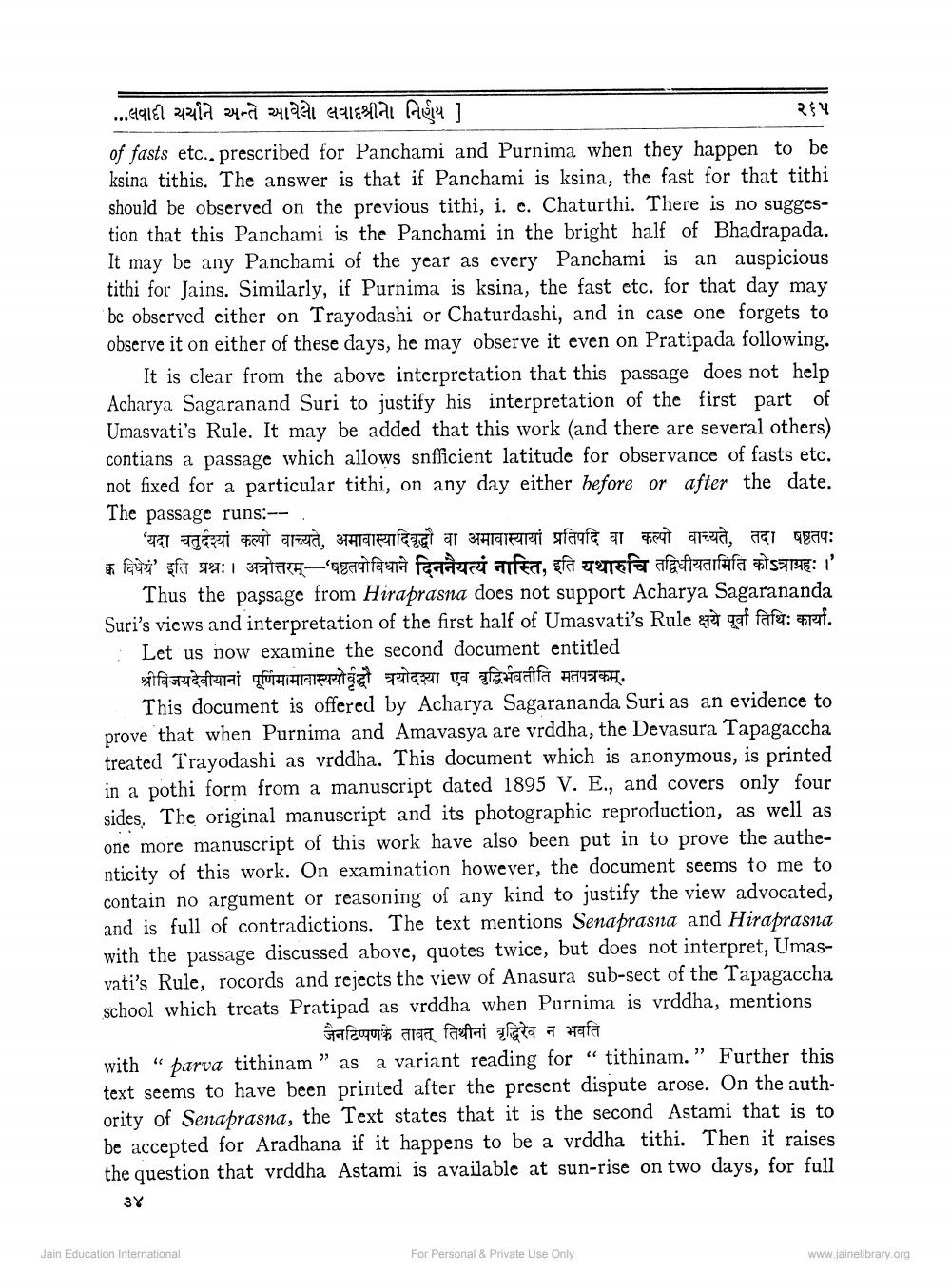________________
લવાદી ચર્ચાને અંતે આવેલ લવાશ્રીને નિર્ણય ].
૨૬૫
of fasts etc.. prescribed for Panchami and Purnima when they happen to be ksina tithis. The answer is that if Panchami is ksina, the fast for that tithi should be observed on the previous tithi, i. c. Chaturthi. There is no suggestion that this Panchami is the Panchami in the bright half of Bhadrapada. It may be any Panchami of the year as every Panchami is an auspicious tithi for Jains. Similarly, if Purnima is ksina, the fast etc. for that day may be observed either on Trayodashi or Chaturdashi, and in case one forgets to observe it on either of these days, he may observe it even on Pratipada following.
It is clear from the above interpretation that this passage does not help Acharya Sagaranand Suri to justify his interpretation of the first part of Umasvati's Rule. It may be added that this work (and there are several others) contians a passage which allows snfficient latitude for observance of fasts etc. not fixed for a particular tithi, on any day either before or after the date. The passage runs:--.
'यदा चतुर्दश्यां कल्पो वाच्यते, अमावास्यादिवृद्धौ वा अमावास्यायां प्रतिपदि वा कल्पो वाच्यते, तदा षष्टतपः क्क विधेय' इति प्रश्नः। अत्रोत्तरम्—'षष्ठतपोविधाने दिननैयत्यं नास्ति, इति यथारुचि तद्विधीयतामिति कोऽत्राग्रहः ।'
Thus the passage from Hiraprasna does not support Acharya Sagarananda Suri's views and interpretation of the first half of Umasvati's Rule i gaf fafet: arif.
Let us now examine the second document entitled श्रीविजयदेवीयानां पूर्णिमामावास्ययोवृद्धौ त्रयोदश्या एव वृद्धिर्भवतीति मतपत्रकम्.
This document is offered by Acharya Sagarananda Suri as an evidence to prove that when Purnima and Amavasya are vrddha, the Devasura Tapagaccha treated Trayodashi as vrddha. This document which is anonymous, is printed in a pothi form from a manuscript dated 1895 V. E., and covers only four sides. The original manuscript and its photographic reproduction, as well as one more manuscript of this work have also been put in to prove the authenticity of this work. On examination however, the document seems to me to contain no argument or reasoning of any kind to justify the view advocated, and is full of contradictions. The text mentions Senaprasna and Hiraprasna with the passage discussed above, quotes twice, but does not interpret, Umasvati's Rule, rocords and rejects the view of Anasura sub-sect of the Tapagaccha school which treats Pratipad as vrddha when Purnima is vrddha, mentions
जैनटिप्पणके तावत् तिथीनां वृद्धिरेव न भवति with“ parva tithinam ” as a variant reading for “ tithinam.” Further this text seems to have been printed after the present dispute arose. On the authority of Senaprasna, the Text states that it is the second Astami that is to be accepted for Aradhana if it happens to be a vrddha tithi. Then it raises the question that vrddha Astami is available at sun-rise on two days, for full
Jain Education International
For Personal & Private Use Only
www.jainelibrary.org




